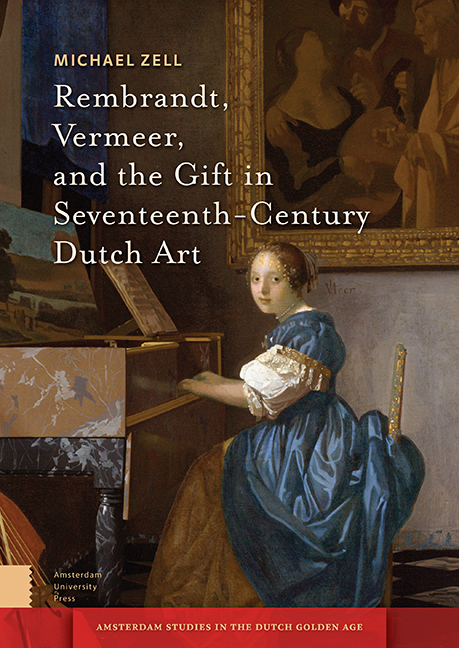Book contents
- Frontmatter
- Dedication
- Contents
- Illustrations
- Acknowledgments
- Introduction
- 1 The Gift and Art in Early Modernity
- 2 Art as Gift in the Dutch Republic
- 3 Rembrandt’s Art as Gift
- 4 Art and Leisure: Amateur Artists, Rembrandt, and Landscape Representation
- 5 For the Love of Art: Vermeer and the Poetics of the Gift
- Conclusion
- Bibliography
- Index
- Frontmatter
- Dedication
- Contents
- Illustrations
- Acknowledgments
- Introduction
- 1 The Gift and Art in Early Modernity
- 2 Art as Gift in the Dutch Republic
- 3 Rembrandt’s Art as Gift
- 4 Art and Leisure: Amateur Artists, Rembrandt, and Landscape Representation
- 5 For the Love of Art: Vermeer and the Poetics of the Gift
- Conclusion
- Bibliography
- Index
Summary
In 1639 Rembrandt wrote to Constantijn Huygens, Secretary to the Dutch Stadholder Frederik Hendrik, that he was sending a monumental painting, likely The Blinding of Samson of 1636 (Fig. 93), as a token of appreciation for Huygens's role in securing payment from the Prince for an important commission. Rembrandt was motivated by what he describes as Huygens's “kind inclination and affection,” and sought to nurture a bond of mutuality with the statesman as his “obliging and affectionate servant.” With gracious and affective language Rembrandt thus recorded for posterity his participation in the culture of gift giving, one of the most important institutions of interpersonal exchange and social interaction of early modernity. Far from anomalous, Rembrandt's gift exemplifies an important feature of the Dutch art world, which is so often presented in commercial terms. In the merchant republic's vibrant and diversified market for art, networks of gift relations and the anti-economic rhetoric of the gift mingled with the growing dimension of commerce. Exploring the interaction between the gift's symbolic economy of reciprocity and obligation and the artistic culture of early modern Holland, this book offers a new perspective that reveals a unique and richly creative chapter in the interconnected history of gift giving and artistic creativity.
The gift economy was indispensable to Dutch burghers for building and sustaining professional and personal bonds, and a vital means of demonstrating social values of goodwill, trustworthiness, virtue, and honor. As a consequence, a broad array of objects and services circulated in the form of gifts, including artworks. The Dutch state, too, regularly offered works of art as diplomatic gifts, the prime currency of international relations in seventeenth-century Europe – most ostentatiously with the “Dutch Gift” of paintings, antiquities, and other luxuries to King Charles II of England in 1660. Despite the significance and even fame of these Dutch bestowals of art, the role that gift giving played within the Dutch art system as an alternate economy of reciprocity and honor remains largely unexplored. By contrast, the gift economies of other early modern artistic cultures, particularly Italy, have attracted a great deal of scholarly attention. The Dutch Republic's merchant society and buoyant art market have directed art historical study away from considerations of the gift and toward a relatively limited economic perspective.
- Type
- Chapter
- Information
- Publisher: Amsterdam University PressPrint publication year: 2021



